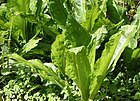Note: This is a project under development. The articles on this wiki are just being initiated and broadly incomplete. You can Help creating new pages.
Difference between revisions of "Symplocarpus foetidus - Skunk cabbage"
(→External Links) |
|||
| Line 89: | Line 89: | ||
[[Category:Herbs]] | [[Category:Herbs]] | ||
| + | [[Category:Ayurvedic herbs that don't have flower, fruit and leaf photos]] | ||
| + | [[Category:Ayurvedic herbs that don't have seed photos]] | ||
Revision as of 16:20, 16 May 2019
Symplocarpus foetidus is a low growing, foul-smelling plant that grows in wetlands of eastern North America.
Contents
- 1 Uses
- 2 Parts Used
- 3 Chemical Composition
- 4 Common names
- 5 Properties
- 6 Habit
- 7 Identification
- 8 List of Ayurvedic medicine in which the herb is used
- 9 Where to get the saplings
- 10 Mode of Propagation
- 11 How to plant/cultivate
- 12 Commonly seen growing in areas
- 13 Photo Gallery
- 14 References
- 15 External Links
Uses
Bronchitis, Vomiting, Headaches, Dizziness, Nervous disorders, Whooping cough, Catarrh, Fever, Epilepsy
Parts Used
Chemical Composition
Characteristic aroma-active compounds in the oils were detected by GC-Olfactometry (GC-O) and aroma extract dilution analysis (AEDA). From the HD method, the main compounds in the oil were found to be p-vinyl-guaiacol (15.5%), 2-pentyl-furan (13.4%), and (Z)-ligustilide (9.5%). From the SAFE method, the main compounds were 2-butoxy-ethanol (49.6%), ethyl-pentanoate (4.5%), and mesitylene (4.0%)[1]
Common names
| Language | Common name |
|---|---|
| Kannada | |
| Hindi | |
| Malayalam | |
| Tamil | |
| Telugu | |
| Marathi | NA |
| Gujarathi | NA |
| Punjabi | NA |
| Kashmiri | NA |
| Sanskrit | |
| English | Skunk cabbage |
Properties
Reference: Dravya - Substance, Rasa - Taste, Guna - Qualities, Veerya - Potency, Vipaka - Post-digesion effect, Karma - Pharmacological activity, Prabhava - Therepeutics.
Dravya
Rasa
Tikta (Bitter), Kashaya (Astringent)
Guna
Laghu (Light), Ruksha (Dry), Tikshna (Sharp)
Veerya
Ushna (Hot)
Vipaka
Katu (Pungent)
Karma
Kapha, Vata
Prabhava
Habit
Identification
Leaf
| Kind | Shape | Feature |
|---|---|---|
| Simple | Alternate | A vibrant yellow-green, springing up along streams and other wetland areas when the rest of the forest floor is still wintry |
Flower
| Type | Size | Color and composition | Stamen | More information |
|---|---|---|---|---|
| Unisexual | 2-6" high | yellow or green | 5 | Inside is the round or ovoid spadix, a fleshy axis bearing the tiny true flowers |
Fruit
| Type | Size | Mass | Appearance | Seeds | More information |
|---|---|---|---|---|---|
| General | 7–10 mm | clearly grooved lengthwise, Lowest hooked hairs aligned towards crown | - | many | {{{6}}} |
Other features
List of Ayurvedic medicine in which the herb is used
- Vishatinduka Taila as root juice extract
Where to get the saplings
Mode of Propagation
How to plant/cultivate
Succeeds in sun or shade in a deep moist to wet lime-free soil that is rich in organic matter[200]. Grows well in a bog garden or along the wet banks of streams and ponds[3]
Commonly seen growing in areas
Photo Gallery
References
External Links
- Ayurvedic Herbs known to be helpful to treat Bronchitis
- Ayurvedic Herbs known to be helpful to treat Vomiting
- Ayurvedic Herbs known to be helpful to treat Headaches
- Ayurvedic Herbs known to be helpful to treat Dizziness
- Ayurvedic Herbs known to be helpful to treat Nervous disorders
- Ayurvedic Herbs known to be helpful to treat Whooping cough
- Ayurvedic Herbs known to be helpful to treat Catarrh
- Ayurvedic Herbs known to be helpful to treat Fever
- Ayurvedic Herbs known to be helpful to treat Epilepsy
- Herbs with Leaves used in medicine
- Herbs with Roots used in medicine
- Herbs with common name in English
- Habit - Herb
- Index of Plants which can be propagated by Seeds
- Index of Plants which can be propagated by Cuttings
- Herbs that are commonly seen in the region of In Marshes
- Herbs that are commonly seen in the region of Bogs areas
- Herbs
- Ayurvedic herbs that don't have flower, fruit and leaf photos
- Ayurvedic herbs that don't have seed photos






